Trees in Delhi are contributing to the environment of the city by providing fresh oxygen, also by improving the air quality, climate amelioration, the conserving water level, preserving the soil, and supporting city’s wildlife. Trees in Delhi are the basis of sustaining life in the city. During in the process of photosynthesis, these trees take in carbon dioxide and produce the pure oxygen for us to breathe.

” Learn Character from a tree, Values from the roots, and change from the leaves “…. Tasneem Hameed
There are so many NGOS for planting trees in Delhi. They are important for us in the city as they give us fresh air to breathe, and shelter and shade from sunlight and rainfall. There are many kinds of medicines are made from the extracts of Flora of Delhi.
Trees in Delhi have always had a significant presence in my life and have been my most beautiful and silent guardian. As I grew up and dependent on the trees as my friends for some emotional reasons. They always offered their love with open arms. I can sense a story of time in them. Trees in Delhi taught me a simple way of art of living. They are like my silent preachers. My friends, in my loneliest moments. I always get motivated by there strength standing tall facing sun, rains and strong winds. Nothing is holier and is best example. Trees in Delhi are really beautiful to me. I spent my child hood watching these trees. They too, looked at me and sure noticed my growing up. As a child I often walk and touch these trees, as I have a relation with them. I am thankful to the beautiful trees in Delhi who not only offered me their cool shades and also umbrella me under the rains on the top they shared my songs of life. Each Tree has its own Zodiac influence as well.
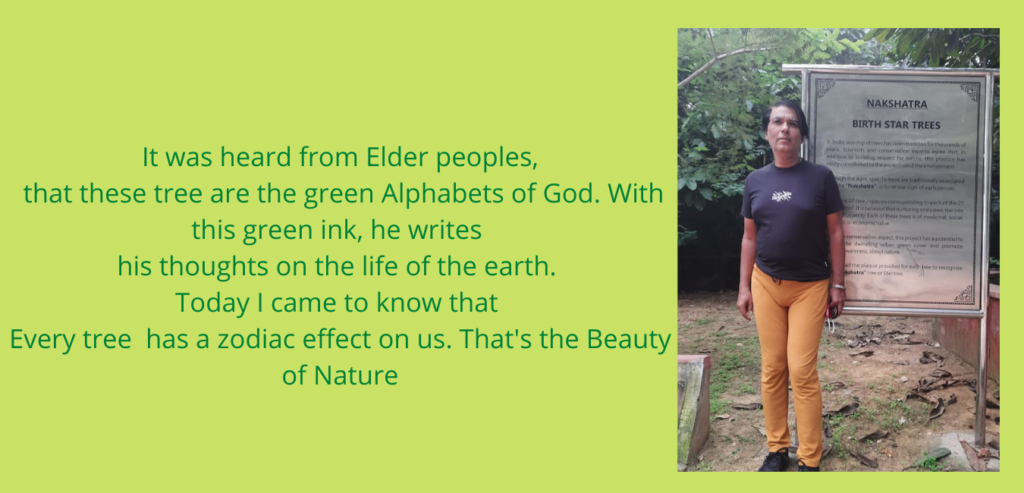
Although there is a lot of forest and greenery near my house, maybe 29% percent of Delhi’s forests {total 87 ha. Of forest are in Delhi} some are near my house. This can also be a reason that I have grown up seeing these trees since childhood. But there are some special trees that you get to see everywhere. They are counts in plenty. It may be favorable for them according to the weather and the land. The history of trees in Delhi is about six hundred years old. In this blog, I will mention those trees which I see in abundance. such trees which are commonly found in Delhi. Total trees in Delhi. Its [145,000] number of trees in Delhi guesstimate.
Tour Guide for Best Places to See in Old & New Delhi
Philkhan Trees is Delhi are common sighted
As they strolled through the serene avenues of Delhi, Harry led Kathrine to an ancient Philkhan tree, its vast canopy providing a cool respite from the afternoon sun. “This is one of the remarkable trees in Delhi,” Harry began, her voice soft but filled with admiration. “The Philkhan is a silent witness to the city’s life—children playing, elders sitting beneath its shade, traffic passing by. These majestic trees have seen it all.”
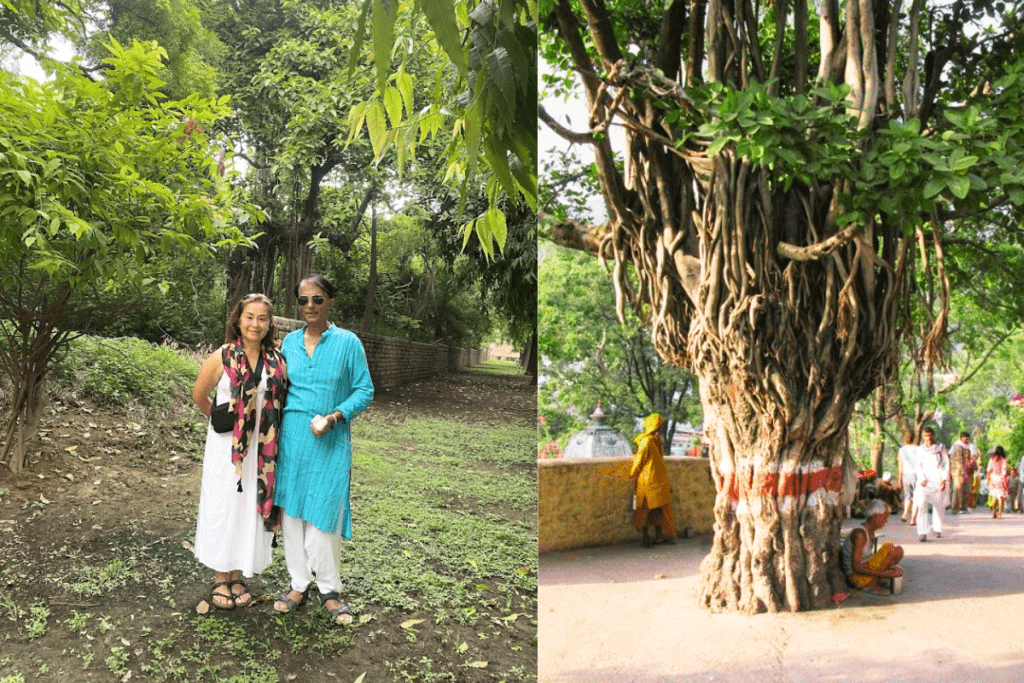
Kathrine gazed up, marveling at the tree’s aerial roots, which gracefully wrapped around its sturdy trunk. “These roots aren’t just for show,” Harry continued. “They grow downwards, searching for the ground to anchor themselves, helping the tree flourish even more. The branches spread wide, offering shade to those who seek solace beneath them, like dogs napping peacefully or elders engrossed in a game of cards.”
As they walked closer, Harry pointed out the delicate new leaves, their pink edges glowing in the dappled sunlight. “The foliage changes with the seasons,” she explained, “turning from a bronze green to deep shades as they age. The Philkhan trees in Delhi are not just ordinary trees; they’re part of the Ficus virens family and can grow up to 30 meters tall. They’re often found on old avenues, their presence as timeless as the city itself.”
Harry paused, smiling as she watched a small bird nestling into one of the tree’s hollowed branches. “These trees aren’t just beautiful,” she said, “they’re a sanctuary. Birds, snakes, and even humans find comfort in their embrace. The Philkhan produces three types of flowers within its fig-like structure, a fascinating process where the female wasp plays a key role in pollination.”
Kathrine listened intently, enchanted not just by the tree but by Harry’s passion for sharing its story. “I never knew the trees in Delhi had such stories to tell,” Kathrine murmured, her heart swelling with affection for both the city and the woman who brought it to life for her.
As they moved on, Kathrine glanced back at the Philkhan, feeling a deeper connection to the history and life of Delhi. It wasn’t just a tree anymore; it was a symbol of endurance, growth, and the quiet beauty that often goes unnoticed. And as they continued their journey, hand in hand, Kathrine knew that this memory, like the Philkhan, would remain rooted in her heart forever.
Bottle Palm Trees in Delhi

The Bottle palm trees in Delhi stands out as a unique and beautiful addition to any garden or public space or a historical monuments. Its distinctive shape and appearance make it a popular choice for ornamental purposes and it can add a touch of exotic beauty to any location. While bottle palms are slow-growing, they can eventually reach a height of up to 10 feet, which makes them a great choice for small gardens or as a statement plant in larger public spaces. In addition to its aesthetic value, the bottle palm is also a hardy plant that can tolerate a range of growing conditions, which makes it a great choice of gardeners for trees in Delhi. Whether used as a specimen plant or as part of a mixed planting scheme, the bottle palm can add a unique and eye-catching element to any green space in Delhi.
Yellow Bell Trees in Delhi
Tacoma stans are drought tolerant and grow well in warm climates. It is cultivated as an ornamental. They are grown in many parts of the world for their beautiful flowers, to decorate roadsides and gardens. Abbreviation of its Mexican name “tecomaxochitl”. The species name means “upright” or “erected”. Yellow trumpet bush blooms best in full sun. It will do well in organically rich and moist, well-drained soil. Now it is found growing all over India. In Mexico, the plant is primarily used to treat type 2 diabetes problem.
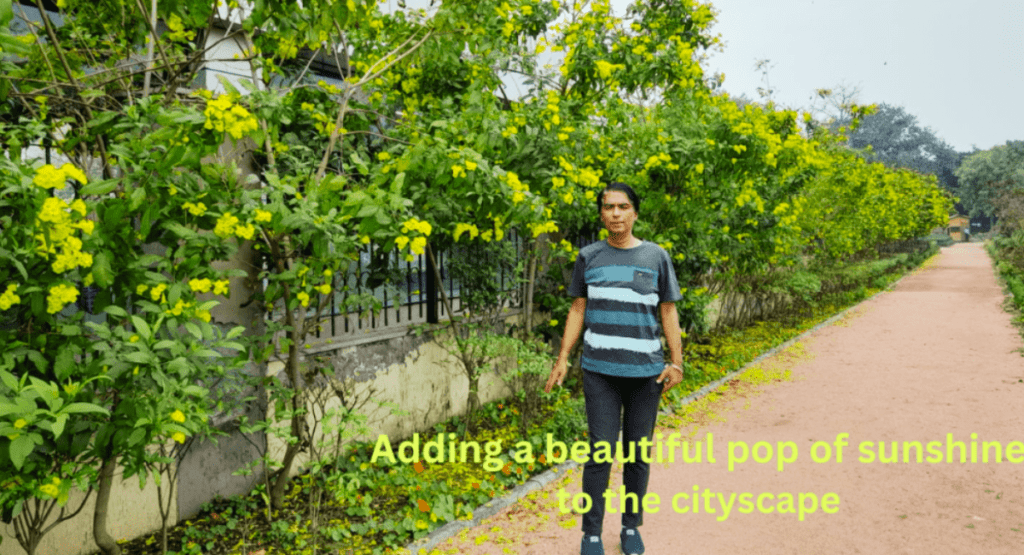
Yellow flowers have the power to enhance the beauty of a city. These bright and cheerful blooms have the ability to transform the dullest of spaces into a lively and inviting environment. Whether they are planted in public parks or along the sides of roads, yellow flowers add a touch of warmth and happiness to any urban landscape. Their vibrant color catches the eye and draws attention, creating a sense of joy and positivity for all those who pass by. The sight of yellow flowers blooming in abundance can lift the mood of a city and bring a smile to the faces of its inhabitants. These Yellow trumpet Tecoma bush is a broad-leaf evergreen shrub or small tree with bright yellow trumpet flowers. The spectacular flowers bloom from spring to frost. In warm climates, they may bloom year-round. In the United States, the shrub typically grows 3–6 feet tall, but can grow to 10–25 feet tall and 10–20 feet wide. The flowers are bright yellow trumpet-shaped and appear in clusters or racemes. The nectar juice of the flowers attracts hummingbirds honey bees and butterflies. Small mammals feed on the seeds, and other mammals graze on the leaves. The plant is a member of the Begoniaceae or trumpet creeper family which consists mostly of tropical trees or shrubs.
Silk Cotton Trees in Delhi
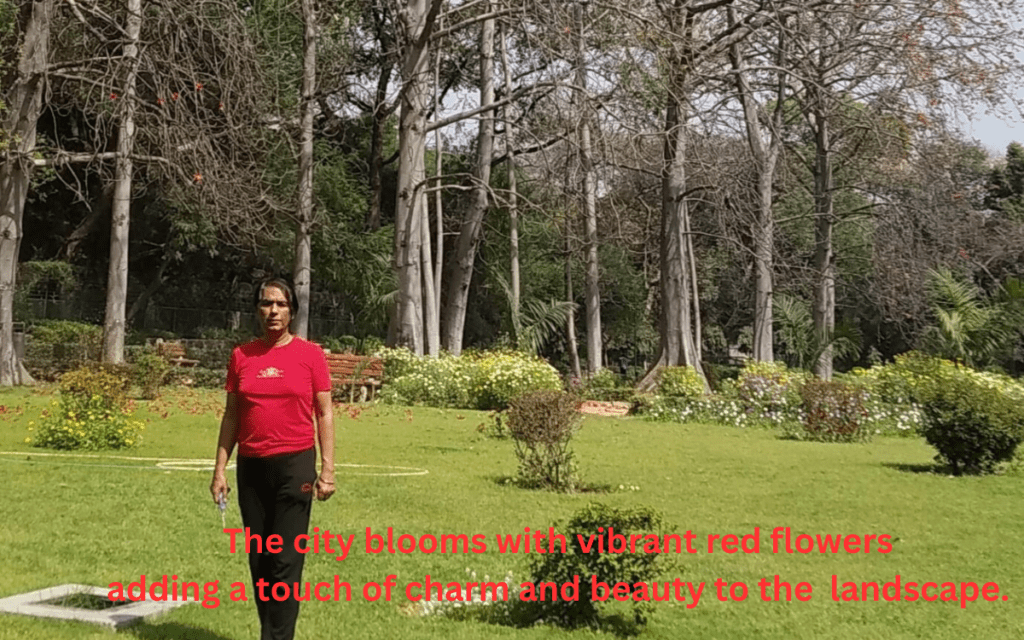
Silk cotton tree is a type of native cotton tree with large red flowers. The name Salmalia is derived from the Sanskrit name Shalmali. The silk cotton tree has eight species of the genus Bombyx, native to India, tropical South Asia, northern Australia, and tropical Africa. Samuel trees produce beautifu lYellow and red flowers from January to March. This carpeted the entire landscape in an alluring red colour. The ping pong ball-shaped fruit ripens in March and April. They are filled with fibrous things like cotton. It is for the fiber that the villagers gather the small fruits and extract the cotton material known as “Kopak”. This substance is used economically for filling expensive pillows, quilts, sofas, etc. The fruits are eaten cooked and pickles are also made. Samuel is a very fast growing tree and can reach a circumference of 2 to 3 m and a height of about 30 m over a period of about 50 years or more. Its wood, when the saw is fresh, is white in colour. However, with exposure and time, it darkens. It is as light as 10 to 12 kg per cubic foot. It is easy to operate except underwater but not durable. So it is famous for its construction work, but it is very good and valuable for making plywood, matches and sticks, scraps, patterns, molds etc. Also for the construction of canoes and light duty boats and other structures required underwater. Bombax species are used as food plants by the larvae of some Lepidoptera species, including the leaf miner Bucculatrix Crateracma, which feeds exclusively on Bombyx ceiba.

Peepal Ficus religiosa Trees in Delhi
Peepal tree is one of the road side trees in Delhi. If you look from afar, it seems that a sage wearing a hairdo, a coiled pad asana, should be a son completely silent and calm, absorbed in his penance. There is a special kind of cultured atmosphere around it. Only by passing by it does one feel like doing it a religious feeling rises in the mind. Peepal trees in Delhi are native to India and thrive in hot, humid weather. They prefer to have full sunlight and can grow in most of the soil types, though loam [ balance of silt, sand and clay] is the best. The peepal is medium sized tree and has a heart shaped leaf. The fig of the Peepal tree house the flowers and grow in the pairs. The berries are purple in colour and also grow in pairs. The peepal tree, which is Ficus religiosa, also known as a “bodhi” tree, is a sacred to those of the Buddhist faith. Peepal tree is believed to be one of the personifications of Buddha. Cuttings from this tree exist in Sri Lanka that date back to 285 B.C. The Peepal trees in Delhi is said to be ‘Tree of Life’ even it is true in the scientific sense. Unlike all other trees, they release oxygen by day and even at night. According to the Ayurvedic science of every part of Pipal tree is useful for treating numerous health issues and ailments. This tree can cure as many as fifty disorders, including diarrhoea, epilepsy and gastric troubles. peepal trees in Delhi are a large, tall deciduous tree. Sometimes juice of tree bark is used as a mouthwash, for curing toothache and weak gums
Trunk of Peepal trees in Delhi is short and thick, often fluted and exudes milky latex. Color of the Bark is in yellowish or grey brown, smooth and become scaly with the age. Leaves of Peepal are large with wavy margins and a long stalk, heart shaped at base with very long pointed tip. Figs are always in pairs, grow out from the leaf axils, reddish at first and eventually turned in deep purple when ripe. Peepal trees in Delhi leaves start to fall in January and new leaves emerge in the late March to late April. Figs ripen around mid-April. Peepal tree is associated with lot of myths, superstitions and beliefs. It’s a popular belief that watering a Peepal tree is worshipping and circling around the Peepal Tree will bring us wealth, fame and an abundance of happiness in life and good luck for any individual. Women are even advised to do circumambulation around the Peepal tree to overcome their fertility problems and to pray for a long, healthy life for their husbands.
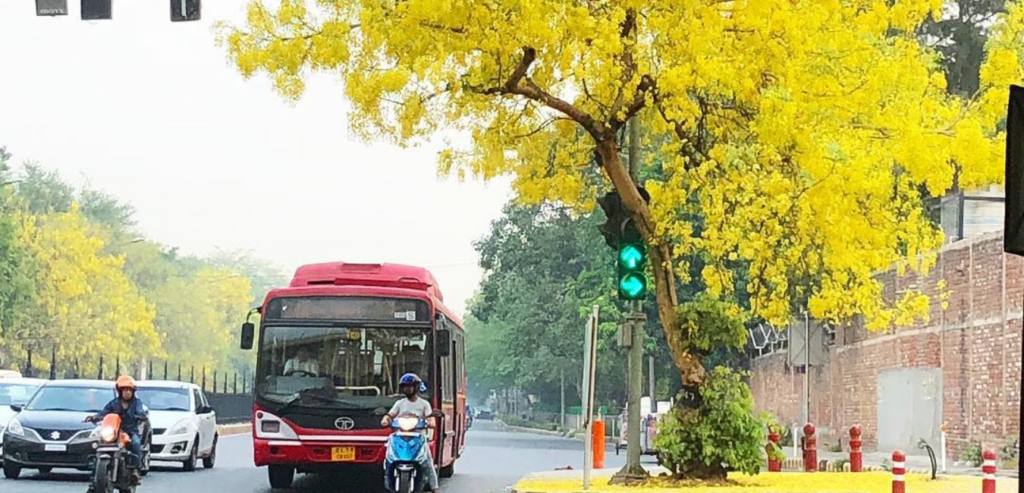
Amaltas is a flowering trees in Delhi
Amalta’s Indian laburnum or Cassia fistula, If you ever go through a residential area, you will definitely see the Amaltas trees. If you look from a far, it seems as if a bridegroom is standing with a beautiful yellow flower’s veil tied on his face. There is a music feel around it. Looks very charming, this Amaltas tree is covered with bunches of bright yellow sprinklers flowers. Often Bollywood film shooting like Silsila. Often in the songs of hero heroine, both the lovers definitely come near this tree. Love is naturally hidden in this tree itself. Amaltas tree is popularly known in Hindi. There are many other common names. the most of the popular ones are the Golden Shower, Pudding Pipe, and the Indian Laburnum. Locally in India, many other names of Cassia fistula are also equally famous. • Cassia fistula popularly known ‘Amaltas’ or ‘Golden shower tree’ dots the sky during peak of summers starting from mid-May to mid-June and even beyond in this region of sub-tropical plains of North India. It gives a profuse flowering which is a complement to the blue sky and gives us a soothing effect in the summer. • The Amaltas tree in Delhi is so packed with yellow flowers that it is difficult to spot a leaf. This is an important reason that Amaltas do not gives too much required shade during the summers time, this tree is overwhelmed with flowers with a insignificant foliage to providing a shade. It is planted along the road side avenues primarily for beautification. It has a Hybrid variety, Cassia alipurens that has a cream color flower. Amaltas tree belongs to the family Fabaceae and sub family of Caesalpinioideae. A fast-growing medium sized perennial tree about 25 to 50 feet in height. It spreads its branches and a greenish grey bark. It is a deciduous tree which means it shed its leaves. Which again reappear after the bloom is over towards the LAST of April. If you want to see Nature manifest and its generosity, it can be a good study. In May it’s in a yellow, soft green buds appear in such profusion, when May is on the peak, dazzling yellow colour pendulous like chandeliers hang graciously, with such compelling beauty, you are just awestruck. A fresh flush of yellow flowers takes the trees in a loving embrace. By now Amaltas starts to paint the city in yellow. Each flower is like a masterpiece, each tree is an art gallery. It is almost like that the God was mixing the yellow colour paints to get the best hue and finally to use all the colours on his palette- gold, amber, citrine… Ones looks away, making the fragrant of the flower look like a graceful dancer in a captivating dancing pose. The fruits are long like a cylindrical pipe popular as fistula in Latin, with seeds are arranged neatly like a little compartment of a goods train. The soft strong-smelling attracts pigs and monkeys, even caterpillars, civets and porcupines are all unwitting agents in the propagation of this riveting ornamental tree. The Amaltas is also is a panacea for many ills. It is called Arogvadha in Sanskrit. There is a mention of Amaltas trees in Delhi found in both the ancient religious epics of Ramayana and the Mahabharata. This tree grows slow and sometime takes ten years to flower in full. But with favorable climatic conditions, it may flower in six years. seeds germination is poor. There seeds are little hard, and it is advised by horticulturists to put them in a boiling water for four-five minutes before sowing.

Banyan Trees in Delhi are commonly found
Whenever I look at the huge Banyan trees in Delhi, it feels me like an old person seems my grandfather is sitting at a special place like the Poarch in the house with a power, honor and fear on his face. The splendid banyan trees, huge physique body with beautiful wrinkles of knowledge and experience on its face with time. So Quiet, calm silent with a watchful eye on the one who pass by. It is to believed that fig trees have shaped our world, influenced our culture and helped us protect life on Earth. Indian Banyan, Fiscus benghalensis, or Banyan fig, unusually shaped tree of the mulberry family Moraceae native to the Indian subcontinent. The Banyan reaches at the height from 30 meters 100 feet and spreads laterally indefinitely. Aerial roots of the tree that develop from its own branches descend and take root back in the soil to become all new trunks. Elder Banyan trees in Delhi appears of a very dense and thick as a result of its tangled roots and trunks. The leaves of the Banyan tree are large, green, leathery, glossy, and in elliptical like most other figs, the leaf buds of the Banyan is covered with two large scales.
It is to be said that first Europeans to encounter with the banyan tree was Alexander the Great, who reached India in 326 BCE. Took back home to Greece informed Theophrastus, the founder of modern botany, 17thcentury English poet Mr. John Milton wrote in his book Paradise Lost that Adam and Eve made their first clothes from banyan tree leaves. Indian banyan, Fiscus benghalensis, or banyan fig, unusually shaped tree of the mulberry family Moraceae native to the Indian subcontinent. As the leaf develops the scales abscise. Young leaves have an attractive reddish tinge. Banyan tree fruits are used in medicines for deadly diseases, for thousands of years, people have used banyans as sources of medicines their benefits are mentioned in science of Ayurveda Banyan fruits are rich in mineral salts, antioxidant and analgesic properties that are helpful in reducing the risk of coronary heart disease ranging from high blood pressure. The fruit of this tree is rich in calories, carbohydrates, sugar, fibre, protein, vitamin B1, vitamin B3. Apart from this, protein, fibre, calcium and phosphorus are found in its leaves
Antioxidants are present in the Banyan tree and beneficial in controlling blood cholesterol levels in the body. Rich in potassium, magnesium, phosphorus, omega 3 and 6, which are very important for a human healthy heart. . the potassium present in Banyan tree fruits is effective in reducing sodium levels. Which removes the problem of frequent urination and beneficial for heart. Bark and leaves of the Banyan are also used for the treatment for skin diseases. Water from banyan leaves can also help in reduce the joint pains. In the Corona time, everyone is trying a new way to increase their power of immunity by consuming Banyan fruit. This fruit is also taken as an immunity booster. Banyan tree fruits are very beneficial and protects you from many diseases and also keeps your cough, cold, flu away.

Gulmohar Trees in Delhi are Beautiful Flowering Trees in Delhi
Gulmohar is a trees in Delhi with red flowers. In fact, the real name of Gulmohar is ‘the flower of heaven’. In the hot summer, Gulmohar tree achieves its limelight from the month of April to June. The Gulmohar trees are the same work of art of the nature. Gulmohar is found in India widely planted as a road as an ornamental tree. Pavements spreads off its delicate fragrance and cooling to the eyes with its excellent shade orange red, ember-like flowers. Its flowers look like a burning fire which looks very beautiful. Its birthplace is considered to be Madagascar. Gulmohar tree is also known as Flame Tree. The French people probably given the most poetic name to Gulmohar, in French language as flower of the heaven. In fact, there are so many flowers that it is difficult to count. It This tree is found everywhere in the hot and humid places. Flowers of the Gulmohar are a best source of nectar. Honey bees fly a lot on flowers. Along with nectar, they also get a pollen from these flowers. Pollination source from flowers is mainly by birds. This beauty was discovered in the 19th century Madagascar by botanist Wesnel Bojer. Since then, admirers’ generosity has increased. Gulmohar has come from a dry deciduous region of Madagascar When its flowers are all around on the tree, it also known as the light of the forest. english name is flamboyant. It is easly visible in the forest due to its bright colour. Fast growing tree and the average age is around fifty years. Gulmohar trees in Delhi starts blooming in the beginning of May. When these flowers are in full bloom, then a different beauty is seen in the whole environment. there flowers are 30 to 70 cm Gulmohar is a flowering tree belonging to the family Fabaceae is commonly known as the legume, pea, or bean familyThe tree is mighty and grows to a height of 30 to 40 feet tall. The spread of a Gulmohar tree is fast and forms a flat-topped umbrella like crown. The branches spread wide far to build a beautiful canopy.

Ashoka Tree is a Common Trees of Delhi
ASHOKA Trees in Delhi is one of the most handsome trees stands like a gentle man. Ashoka tree is a legendary. The meaning of Ashok in Sanskrit is without grief/ sorrow less and holds an invaluable importance in Hinduism, Buddhism, and Jainism. Ashoka tree is an evergreen tree around 15-20 meters in Hight. The leaves of Ashoka are 15cm long and oblong in shape. Flowers of Ashoka tree are polygamous, yellowish, orange and scarlet colors produces a sweet smell throughout the year and profuse flowers blooms in the month of February to May. Ashoka tree as a plant grows faster in tropical and sub-tropical situation.
All parts of the Ashoka tree Such as bark, leaves, flowers and seeds are used medicinally and cures many disorders; hence it is known as universal tree. The bark is comprised of a sodium, silica, magnesium, iron, calcium, aluminum and strontium. There are other components include like sterol, tannins, catechol and some calcium compounds. gynaecological reduces excessive and painful bleeding, leucorrhoea problems of women As the bark contains kestrel, it treats uterine fibroids and other internal fibroids and is one of the most common household remedies for uterine disorders. Medicine prepared from the bark also helps in removing stomach worms and comforts from swelling. Dried flowers are used to cure diabetes. It adds ease for indigestion and dysentery. Medicine prepared from the leaves, flowers and barks are used to cure diarrheic and also purification of the blood. Medicine prepared from the extract of Ashoka tree can be used for the cure of piles and bleeding and kidney stones. The ground seed as a powder used as a memory enhancer.
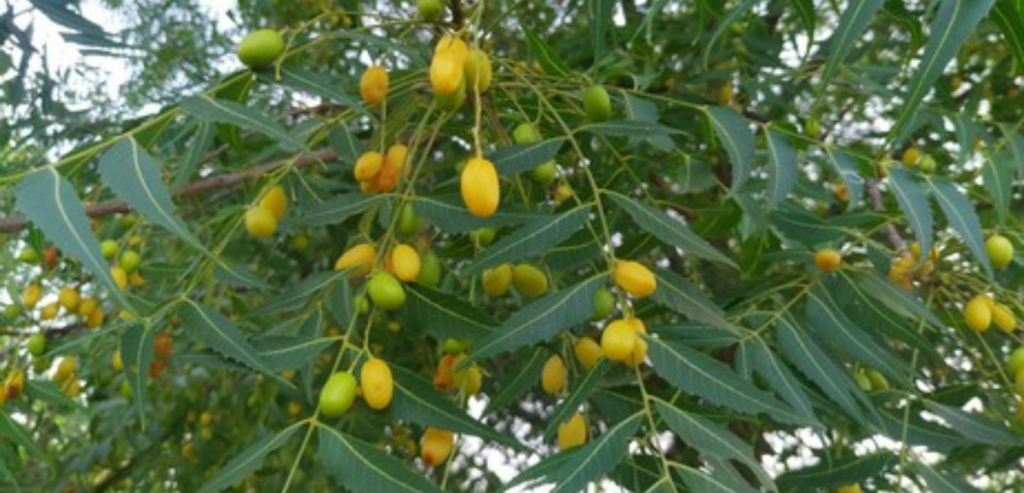
Neem Trees are commonly found in Delhi
Tooth cleaning with neem twigs Neem tree is often seen. Neem trees in Delhi and grows fast. which can reach up to the height of 45 to 65 feet, Neem tree is a deciduous, shedding lots of its leaves during the dry winter months. The branches of Neem are wide and spreading. The fairly dense crown is roundish shape may reach a diameter of 20–25 mt66–82 ft. White with fragrant flowers of Neem are arranged in more or less in drooping axillary panicles which are up to 25 cm. branches bear from 250 to 300 flowers. An individual flower is 5 to 6 mm and 8–11 mm wide. Flowers Are bisexual and male flowers and exist on the same individual tree. The fruit is a smooth globous, olive-like drupe which varies in shape from elongate oval to nearly roundish, and when ripe is 14–28 mm. The fruit and the skin is thin and the bitter in sweet pulpy is yellowish-white and very fibrous. The mesocarp is 3–5 mm (1⁄8–1⁄4 in) thick. The white, hard inner shell of the fruit encloses one and two, sometimes three, are long and thin seeds (kernels) having a brown seed coat. The neem tree is noted for its drought resistance. Neem can grow in different types of soils, but best thrives on a well-drained deep and sandy soils. They are not at all delicate about water quality and thrive on the , whatever the quality is available. In Delhi and tropical places, Neem trees used for shade lining in the streets, around the temples, schools and various other public buildings or in most people’s back yards. Neem tree was introduce in Australia in 1940s. A. Indica was originally planted in the Northern Territory to provide shade for cattle. Neem tree fruits, seeds, leaves, stems, and the bark contain diverse phytochemicals and the seed oil contains glycerides, imboiled, triterpenes, diverse polyphenols and beta sitosterol. The yellow, bitter oil has a garlic like smell and also contains about 2% of limonoid compounds. The leaves contain carotenes, quercetin, catechins, , and vitamin C. Neem leaves are dried and placed in cupboards to prevent insects eating the woolen clothes, and also in tins and jars where grain is stored. The soft little shoots and flowers of the neem tree are eaten as a vegetable. A soup-like dish called “neem flower Ras am” made of the flower of neem Products made from neem trees have been used in the traditional medicine of India for centuries, but there is insufficient clinical evidence to indicate any benefits of using neem for Neem is a key ingredient in non-pesticide management and providing a natural alternative to the synthetic pesticides. Neem oil cake is used as a fertilizer there seeds are ground into powder and soaked overnight in the water and sprayed on the crops. As Neem does not kill insects directly. It acts as an anti repellent, and also suppresses the subsequent hatching of their eggs.


Sheesham Tree Dalbergia sissoo English
In my childhood, my father always use to point sheesham trees in Delhi, that they are good for carpenters as of their soft nature. Since I always feel this tree like me. They are known as North Indian rosewood. Fast-growing, and benefits of the sheesham tree is, its innate resistance to decay and is famous for woodcarving and for engraving items in India. Sheesham tree wood neither warps and never splits, so it is pretty used for making inner doors, study shelves and different dezines for kitchenware products. Sheesham wood generally being golden brown to a range of darkish brown or to chestnut in color with some darker streaks that makes this wood a rich and lustrous in look. It has a quality of resistance to decay and this reason is famous for woodcarving and for beautiful engrave items. sheesham tree in Delhi is banned, was enlisted in the Appendix-II of the CITES in 2016. There’s a [punishment of cutting trees in Delhi] can survive in almost any kind of well-draining soil. Alluvial soil, mixed with gravel or sandy loam that drains excess water but stays moist, is ideal for growing. Sheesham trees in Delhi also grow in slightly saline soil. This tree generally grows alongside streams, nuallas and riverbanks. It grows in a pleasant temperature ranging from 10°C to 40°C. it is able to resist an average rainfall and droughts but not exceeding three to 4 months.









